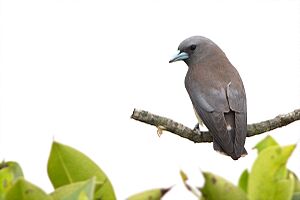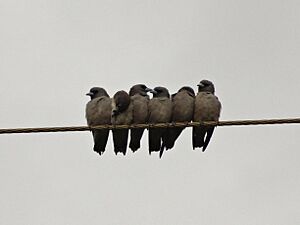Ashy woodswallow facts for kids
Quick facts for kids Ashy woodswallow |
|
|---|---|
 |
|
| At Sundarban Tiger Reserve, India | |
| Conservation status | |
| Scientific classification | |
| Genus: |
Artamus
|
| Species: |
fuscus
|
 |
|
| Global range Year-Round Range Summer Range Winter Range | |
The ashy woodswallow (Artamus fuscus) is a bird found in South Asia. It is sometimes called the ashy swallow-shrike. Like other woodswallows, it has a short, curved beak and a short, square tail. Its wings are long. You can often see these birds perched together in groups. They like to sit high up on power lines, tall bare trees, or in areas with many tall palm trees.
What Does It Look Like?

This bird is quite strong and has a grey back. Its head is a bit darker. It has a light band on its lower back. The belly is a pinkish-grey color. Its short, dark grey tail has a white tip. The beak looks like a finch's beak and is silvery.
When it flies, its long wings look very wide near the body. This makes them appear like a triangle. The bird's legs are short. Ashy woodswallows often perch on high spots. From there, they fly out to catch insects in the air. All ashy woodswallows look similar, no matter where they live. It is hard to tell male and female birds apart just by looking at them. Young birds have some stripes on their belly.
Where Do They Live?
Ashy woodswallows live in many different places. You can find them in flat areas or up to about 2,000 meters high. They like cultivated lands and open spaces in forests. They are often seen where there are tall palm trees.
These birds are found across many countries. This includes Bangladesh, India, Nepal, Sri Lanka, Thailand, Myanmar, Laos, Malaysia, and China. They do not live in the very dry parts of western India. They have also been seen on the island of Maldives.
How Do They Behave?
Ashy woodswallows usually hang out in small groups. You might see several birds sitting close together. They often huddle on bare branches of a tall tree. Sometimes, they even preen each other's feathers. They also like to perch on high places like power lines.
From their perches, they fly out to catch insects. They flap their wings and glide to grab insects in the air. They can catch insects with their beak. Sometimes, they hold the insect in their feet. They might tear it up with their beak and swallow it while flying. They can also return to their perch to eat their prey. These birds have been known to sit on the ground. They also visit bird baths to drink or clean themselves.
Even though they mostly eat insects, they sometimes drink nectar from flowers. For example, they might drink from Erythrina trees. Interestingly, they have been seen eating butterflies that are poisonous to other birds. An example is the Euploea core butterfly.
Family Life
In India, the ashy woodswallow's breeding season is from March to June. They build a shallow, cup-shaped nest. They often place it high up. This could be at the base of a tall palm tree leaf. Or it might be in a hollow spot on top of a street light pole.
A female bird usually lays 2 to 3 eggs. The eggs are greenish-white with brown spots. Both parents help build the nest. They also take turns sitting on the eggs to keep them warm. And they both feed the young birds once they hatch. If bigger birds like crows or birds of prey come too close, the woodswallows will chase them away.
Their song is a mix of squeaky sounds. It can even include sounds that copy other birds' calls. Their usual call is a loud, nasal chewk. These birds might move to different areas depending on the rainfall.



